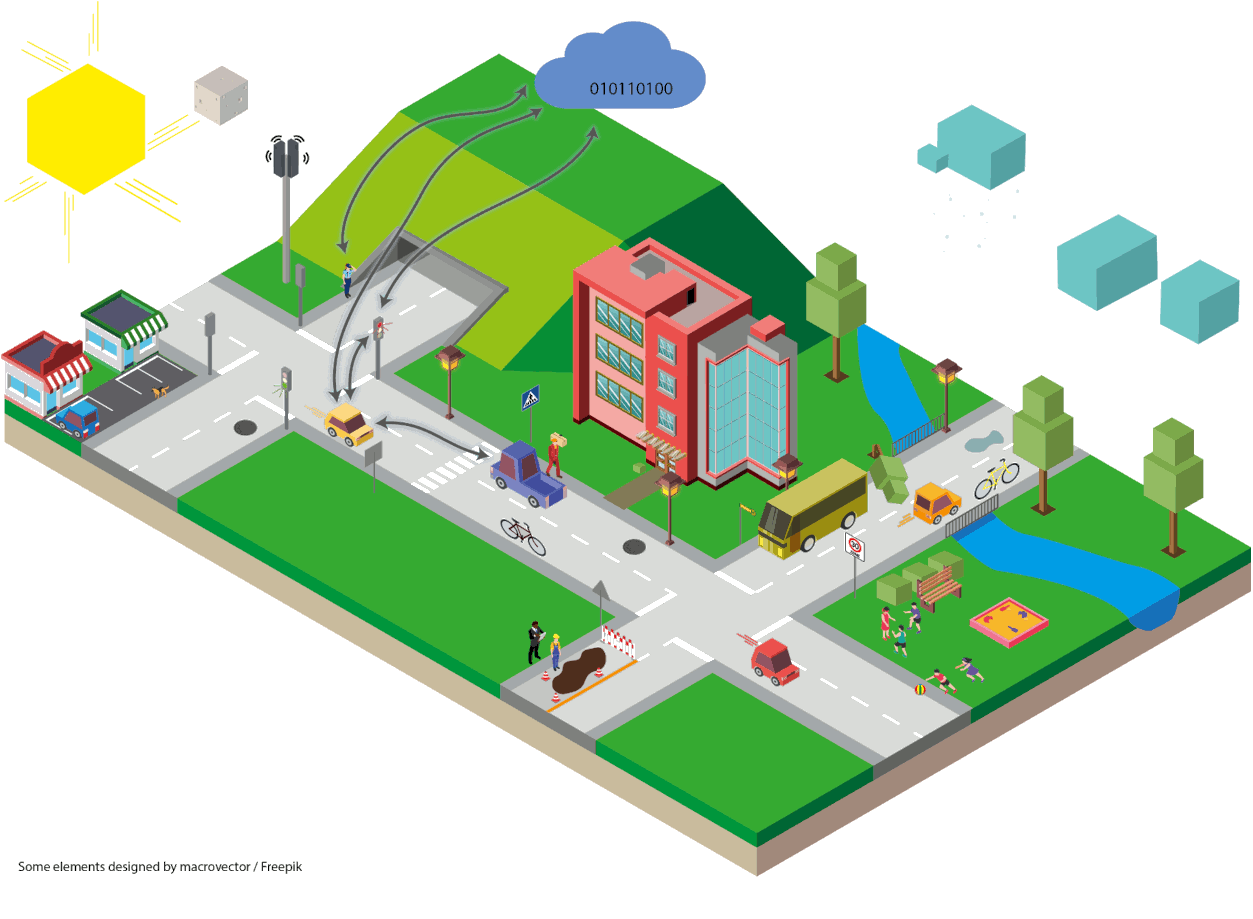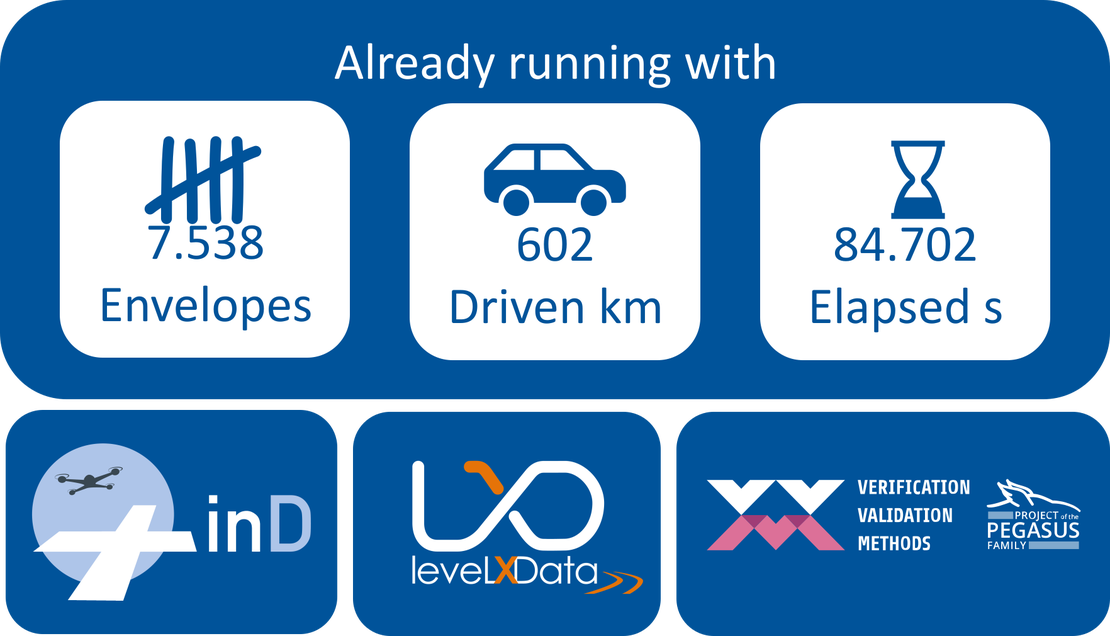About the Concepts
For efficient structuring, storing and handling, an underlying scenario concept is developed for the database. It follows the categoriation of the 6 layer model and describes scenarios relatively to an ego road user. Thereby, scenarios are described and modeled on different abstraction layers to suit the users accordingly to its use case. A scenario is thereby defined as a sequence of scenes which can include actions and triggers and has an assigned ego road user. A scenario has a duration of typically 10 seconds and includes e.g. an intersection, a roundabout or a usual street.
Levels of Abstraction
For systematic description and easy usage, scenarios are described on different abstraction layers.
- Functional/ abstract scenarios: On the highest level scenarios are described verbally for easy searches.
- Logical scenario classes: Derived from abstract scenarios, logical scenario classes serves as a blueprint for parameters, attributes and relations to detail the abstract scenario and to generate concrete scenarios.
- Logical scenario instances: Filled with actual data, distributions within a logical scenario class are modeled.
- Concrete scenarios: Sampling logical scenario classes, concrete scenarios arise and can be used for simulations in OpenX format.
Attributes and Parameters
Scenarios are described by attributes and parameters for optimized seach and generation.
- Attributes are used to describe scenarios comprehensively including positioning, timetoX metrics (e.g. THW, TTC, PET, timegap), occlusion, events and many more. So, for scenario can be searched via multiple attributes according to the actual use case. So, attributes aim to make every important aspect of a scenario searchable.
- Parameters are dedicated to describe a scenario for generation. Inspite of attributes, parameters are thereby distinct or relations a re made explicit to prevent meaningless constellations and parametrizations. Thereby, different parametrizations are possible to describe the same scenario according to the actual needs.
Base and Focus Scenarios
How much complexity is needed? We describe all traffic relations between ego and object in any structured environment in less than 300 base scenarios. Easy to search - easy to generate. Thereby, those scenarios are build on a comprehensive ontology, so that scenarios used are derived systematically from given concepts. To allow for more complexity, combinations of those are called focus scenarios and can be used for more complex modeling. Within focus scenarios, multiple base scenarios are combined sequentially, in parallel or are adapted from the original base scenario to serve the dedicated use case.
Replay and Advanced Replay to Sim
Next to parametrizations of scenarios which abstract the reality, highest accuracy to simulate scenarios is done in a seperate branch without parameters for abstraction with replays of real-world data. Thereby, all components behave as they did in real-world. To still account for flexibility of scenarios according to potential ego behaviors, an advanced replay to sim is developed. This accounts for changes and adapts it to improve the realisticness of the new situation in OpenX standard.
Coverage and Completeness
How many scenarios are enough for sufficient testing? And is a proper set of scenarios chosen? For this, a method for proving the completeness of the scenario concept is used and applied to our scenario concept. Furthermore, coverage based on real-world data in the database can be approximated based on the limitations of input data.
References
Our scenario concept was developed and aligned in the safety assurance research project VVMethods. Learn more in our publications:
- M. Schuldes, C. Glasmacher, L. Eckstein “scenario.center: Methods from Real-world Data to a Scenario Database”, 35th IEEE Intelligent Vehicles Symposium, June 2 - 5, Korea, 2024
- C. Glasmacher, H. Weber, l. Eckstein “Towards a Completeness Argumentation for Scenario Concepts”, 35th IEEE Intelligent Vehicles Symposium, June 2 - 5, Korea, 2024
- C. Glasmacher, M. Schuldes, P. Topalakatti, P. Hristov, H. Weber, L. Eckstein “Deliverable D13: Scenario-based Model of the ODD through Scenario Databases”, VVMethods Deliverable, 2023.
- H. Weber, C. Glasmacher, M. Schuldes, N. Wagener and L. Eckstein “Holistic Driving Scenario Concept for Urban Traffic”, in Intelligent Vehicle Symposium, Anchorage, 2023.
- C. Glasmacher, H. Weber, M. Schuldes, N. Wagener and L. Eckstein “Generation of Concrete Parameters from Logical Urban Driving Scenarios Based on Hybrid Graphs”, in VEHTIS, Prague, 2023.
- C. Glasmacher, M. Schuldes, H. Weber, N. Wagener and L. Eckstein “Acquire Driving Scenarios Efficiently: A Framework for Prospective Assessment of Cost-Optimal Scenario Acquisition”, ITSC, Bilbao, 2023.
- M. Scholtes, L. Westhofen, L. Lotto, M. Schuldes, H. Weber, N. Wagener, C. Neurohr, M. Bollmann, F. Körtke, J. Hiller, M. Hoss, J. Bock, L. Eckstein “6-Layer Model for a Structured Description and Categorization of Urban Traffic and Environment”, in 4. Uni-DAS e.V. Workshop Fahrerassistenz und automatisiertes Fahren, Berkheim, 2022.









